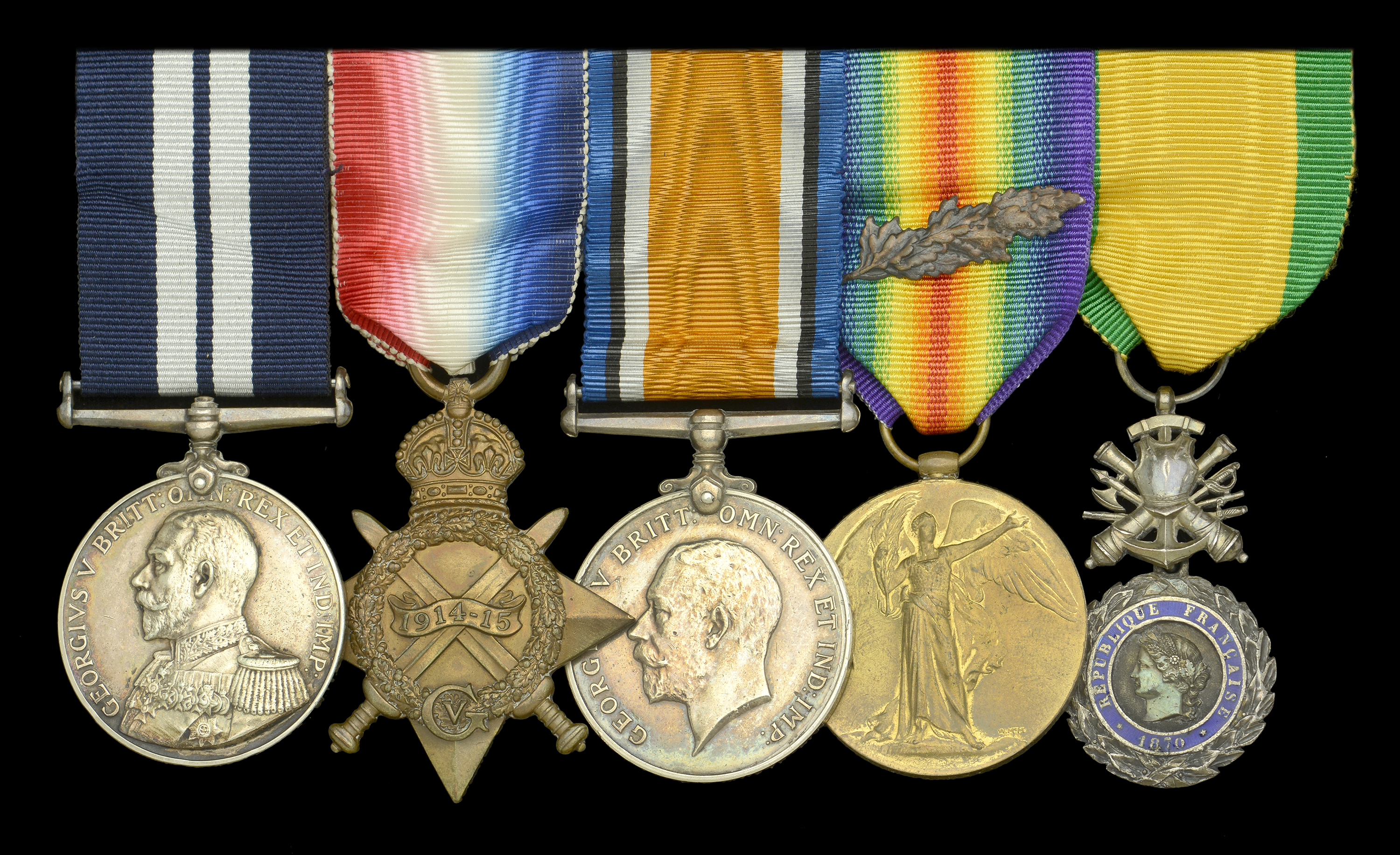A Battle of Jutland D.S.M. group of five awarded to Warrant Shipwright M. Bray, Royal Navy, who was fortunate to survive the 17-and-a-half minute mauling of the cruiser H.M.S. Warrior, in which 71 of her crew were killed and many others wounded Distinguished Service Medal, G.V.R. (343524. M. Bray, Shpt. 1Cl. H.M.S. Warrior. 30 May-1 June 1916.); 1914-15 Star (343624. M. Bray, Shpt. 1., R.N.); British War and Victory Medals, with M.I.D. oak leaves (Wt. Shpt. M. Bray. R.N.); France, Medaille Militaire, silver, silver-gilt and enamels, mounted as worn, very fine (5) £1,400-£1,800 --- Importation Duty This lot is subject to importation duty of 5% on the hammer price unless exported outside the UK --- --- D.S.M. London Gazette 15 September 1916: ‘For services rendered in the action in the North Sea on the 31 May-1 June 1916.’ The original recommendation states: ‘Specially recommended for his untiring zeal and ability and excellent example in organising the carpenter’s staff, after the Chief Carpenter had been killed. He was continually employed shoring up the bulkheads and holes in the ship’s side and upper deck after the action until the ship was abandoned.’ Martin Bray was born in Calstock, Cornwall on 22 May 1885, and entered the Royal Navy as a Boy Shipwright in July 1900. By the outbreak of war in August 1914, he was serving as a Shipwright 1st Class in the cruiser H.M.S. Warrior, and he was likewise employed at the time of her part in the battle of Jutland. Jutland On that memorable occasion, Warrior was hit by at least 15 11-inch and six 5.9-inch shells, and suffered a loss of 71 killed, in addition to many wounded. Warrior’s surgeon, Lieutenant Charles Leake, R.N., later wrote: ‘In all we had 80 or so killed or died of wounds soon after the action. Having sorted out the wounded as far as possible, it was obvious something more must be done. The wounds were very ragged as caused by pieces of metal. Compound fractures were common and limbs had been torn off. Of the survivors the majority had wounds of the lower extremities. Several had limbs smashed to pulp and had embedded pieces of clothing and metal which needed removal. We commandeered the bathroom near the sick bay as a theatre … We boiled our instruments and set to work. No gloves were served out. These would have been invaluable as in a short space of time one’s hands became fearfully sore owing to antiseptic solutions. The Fleet Surgeon operated, assisted by myself, and Dr. MacDonald gave the anaesthetic. We commenced at 9.30 and went on until 5 next morning when one had to cease owing to the fearful tossing of the ship received in the heavy seas. All sorts of wounds were dealt with and several amputations were done – plain circular, no folds. Needless to say, several men were beyond hope of recovery and others had died whilst waiting their turn – plainly from shock.’ Later that morning it became clear that the Warrior was in a sinking state and her wounded were brought up on deck. As heavy seas swept across her amidships, the Engadine came alongside to commence embarking her crew and, amidst dramatic scenes - for some men fell between the two ships - a remarkable rescue operation was enacted at record speed. The day after her sinking, Warrior’s captain, Vincent Molteno, wrote to his surviving sailors to commend them on their bravery, noting they had ‘behaved magnificently’. He also asked for 10 days’ leave so that they could go ashore, see friends and family and be ‘cock-a-chest’. For his sterling efforts in trying to save the ship, Bray was awarded the D.S.M. and specially promoted to Warrant Shipwright in June 1916. His subsequent seagoing appointments included the cruiser Comus (March 1917-June 1919) and he was placed on the Retired List at his own request in September 1922.
Auctioneer's Buyers Premium: 24% (+VAT)
There is an additional charge of 4.95% (+VAT/sales tax)
See Full Terms And Conditions





